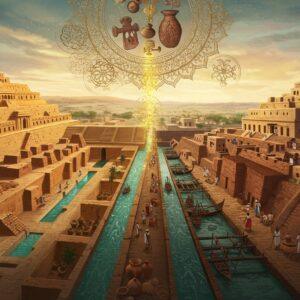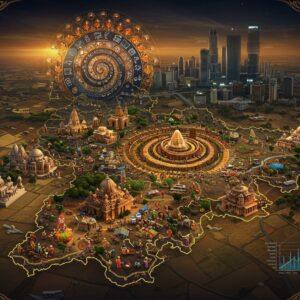
When we speak of royalty in India, the heart often travels to the grand city of Mysore. The very name, Maharaja of Mysore, paints a picture of incredible grandeur, deep-rooted tradition, and a cultural richness that continues to inspire us. This isn’t just a story from history books; it’s a living, breathing heritage, a parampara of the illustrious Wadiyar dynasty that has shaped not just a city, but the cultural soul of our nation.

The Royal Lineage: A 500-Year Saga of the Wadiyar Dynasty
Imagine a family legacy that spans over five centuries! The Wadiyar dynasty holds this unique distinction, having ruled the Kingdom of Mysore from 1399 all the way to 1950. Their story began when two brothers, Vijayaraj and Krishnaraja, journeyed from Dwarka and laid the foundations of a kingdom that would become a beacon of culture and progress.
- From Vassals to Sovereigns: For the first couple of centuries, the Wodeyars ruled as devoted vassals of the great Vijayanagara Empire. But as destiny would have it, with the decline of the empire in the mid-1500s, Maharaja Timmaraja Wodeyar II declared independence, carving out a sovereign path for Mysore.
- Times of Trial and Triumph: The kingdom faced its share of challenges, especially during the latter half of the 18th century under the control of Hyder Ali and his son, Tipu Sultan. Yet, the spirit of the Wadiyars endured. After Tipu Sultan’s fall in 1799, the British restored the kingdom to the dynasty, who then ruled as allies until India’s independence.
More Than Rulers: Patrons of Culture and Progress
The Maharajas of Mysore were not just kings; they were visionaries. Their contributions went far beyond administration, creating a golden age for the entire region. They understood that a kingdom’s true wealth lies in its culture, its art, and the well-being of its people.
A Golden Age for Arts and Culture
The royal court of Mysore was a vibrant hub for artists, musicians, and writers. The Maharajas were passionate patrons, fostering the growth of Carnatic music and commissioning literary works in multiple languages. This deep appreciation for art transformed Mysore into a cultural paradise. This love for art and divinity is something we can all bring into our homes. A beautifully crafted Ganesh Ji photo frame can become the centrepiece of your pooja room, echoing that same reverence for art and faith.
Architectural Marvels That Touch the Sky
The Wadiyars were master builders. Their legacy is etched in stone across the city, from grand palaces to ornate temples. The world-famous Mysore Palace is a breathtaking example of their vision, a jewel of Indo-Saracenic architecture. But their devotion also shines through in sacred places like the Chamundeshwari Temple, a testament to their faith and architectural prowess. These structures are not just buildings; they are stories of a glorious past.

Building a ‘Ramarajya’ for the People
The reign of Maharaja Krishnaraja Wodeyar IV is particularly celebrated as a period of immense progress. He was a true ‘Rajarshi’ (a saintly king), whose administrative reforms transformed Mysore into a model state. So much so that Mahatma Gandhi himself praised his kingdom as “Ramarajya,” an ideal kingdom. Under his rule, Mysore became the first Indian state to generate hydroelectric power in Asia and the first Asian city to have street lights! This commitment to social welfare, education, and public health laid the foundation for modern Mysore.
The Grandeur of Mysore Dasara: A Royal Tradition
The world-famous Mysore Dasara is not just a festival; it’s a royal tradition that owes its grandeur to the Wadiyar dynasty. The spectacular ‘Jumbo Savari’ procession, the lighting of the palace, and the vibrant cultural events are all part of a legacy nurtured by the Maharajas. This celebration is a beautiful reminder of their enduring influence, uniting people in faith and joy.
Answering Your Curiosities about Mysore’s Royalty
Many of us carry questions about this majestic lineage. The ruler, known as the Maharaja of Mysore, was the head of the Wadiyar dynasty, whose legacy is truly monumental. It’s seen in the state’s progress in education, its thriving arts scene, and its robust infrastructure. The Maharajas were pivotal in Mysore’s development, turning it into a modern city while cherishing its ancient traditions.
Their primary residence, the magnificent Mysore Palace, is more than just a home. Its significance lies in its stunning architecture and the history it holds within its walls. It stands today as a proud symbol of their reign and a major attraction for people worldwide. The impact of the Maharajas is felt even today, woven into the cultural fabric of Mysore through its festivals, educational institutions, and the deep sense of identity among its people.
A Timeless Legacy in Modern India
After India gained independence in 1947, Maharaja Jayachamaraja Wadiyar gracefully ceded his kingdom to the Dominion of India, serving the nation as a Rajpramukh and later as a Governor. Even though the titles were abolished in 1971, the respect and love for the royal family remain in the hearts of the people.
The story of the Maharaja of Mysore is a vibrant tapestry of tradition, progress, and unwavering dedication. It’s a legacy that lives on in the grand halls of the palace, the chants from the temples, and the festive spirit of Dasara. It reminds us of a time of royal splendor and visionary leadership, a heritage that continues to make every Indian proud.


